What's Your Release Style? Part 1
May 2013
- by Kelvin Miyahira
A while ago I studied the PGA tour pros and found that the most common release style was the drive/hold method. Meanwhile in average golfer land, what’s going on there? This might be a good time to look at what average golfers are doing and see what they can do to improve regardless of what release style they are using. Ultimately, PGA tour players are using different types of releases and have found ways to make their release repeatable and accurate enough to hold on to the greatest job on the planet... playing golf for a living. But since the differences between release styles can be quite unclear, I’ve catalogued all the different anatomical movement possibilities (from tour pro moves to high handicap amateur moves) related to one’s release thus creating an analysis platform to determine the type of release you’re using. So this month we’ll take a look at all the different ways one can move the club during the impact zone and we’ll use it to determine what release type the new and improved Tiger is using. In part 2 next month, we’ll use it to see what release style amateur golfers are using and how you can improve even if you’re flip/rolling.
Higher Speed = Smaller Margin for Errors
Before we get started with this, let’s remember one important point. The average tour pro is swinging at over 112 miles per hour while the average amateur is swinging closer to 85 mph. It should be noted that a 2 degree error in face angle while swinging at 112 or 125 mph will result in a shot that is far more off line shot than a two degree error at 85 mph. Therefore, we must remember that these guys are good!
Defining the Components of the Release
There are key movement differences that distinguish one release style from another. These movements control clubface angle, rate of closure, loft, angle of attack, low point of swing, swing path and general efficiency of swing. By understanding the variables in swing movements we shall be able to understand what makes a certain release type more inherently unstable and timing dependent versus more consistent and repeatable. So let me start by defining the movements.
Movement possibilities
Body Part | Movements | ||
| left forearm | Early supination | Late supination | pronation |
| left wrist | flexion | extension | |
| left shoulder | Increasing internal rotation | Holding internal rotation | external rotation |
| left shoulder frontal plane | abduction | adduction | |
| left shoulder sagittal plane | flexion | neutral | extension |
| left elbow | flexion | extension | hyperextension |
| right forearm | supination | pronation | |
| right wrist | low rate flexion | Medium rate flexion | High rate flexion |
| right shoulder | Late right shoulder internal rotation | slightly early internal rotation | Early internal rotation |
| right shoulder frontal plane | adduction | abduction | |
| right shoulder sagittal plane | slight flexion holding | Increasing flexion | extension |
| right elbow | flexion | extension | |
| both wrists | max UD post impact | Holding radial deviation | Moving to radial deviation |
| lateral bend | max LB at impact | early loss of LB | no LB |
| Lordosis | holding lordosis | early loss of lordosis | no lordosis |
A player’s release consists of a combination of many movements through the impact zone. There are variations of each of these movements (ie. Timing and rate of execution) which mathematically makes the number of possible release styles daunting. Fortunately for us, some of these movements tend to come in clusters and make it easier for us to categorize them. So let’s first take a look at all the possible movements individually so we can get an idea of what the great ones do and don’t. To simplify, the attributes of the drive/holders are all in the left hand column while those in the middle or right columns are from all the other release styles.
Early Left Forearm Supination or Pronation
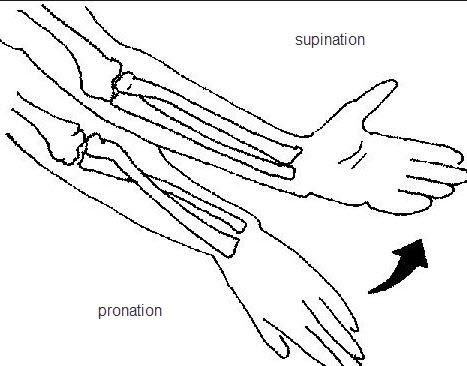
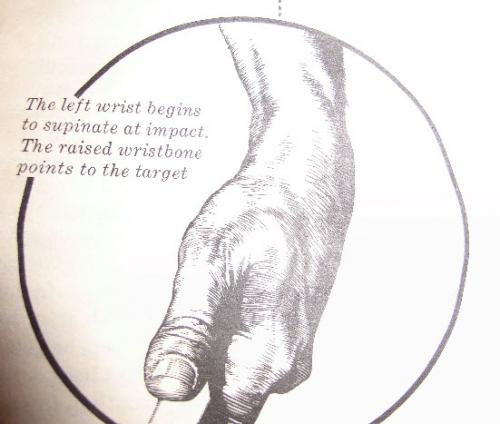
Ben Hogan’s Five Lessons correctly shows a supinated left forearm/left wrist in flexion yet incorrectly stating that it “begins to supinate at impact.” This illustration clearly shows his wrist already in the desirable position. Therefore this movement must have been performed earlier don’t ya think?

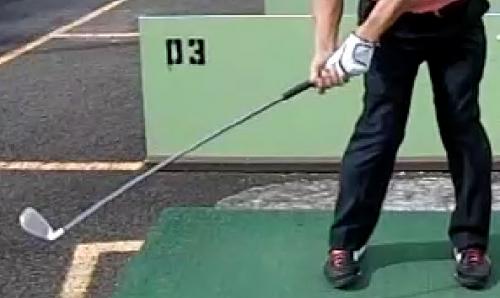
Left forearm supination can be defined as the counter-clockwise rotation of the forearm bones. Left forearm pronation would be the opposite, ie: clockwise rotation. The early supination gets the clubface squared early while pronation keeps the clubface open.
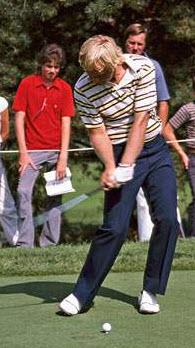

Seems Jack Nicklaus knew a little something about this.
This is a bit different. Lee Westwood has late supination following left wrist extension.
Left Wrist Flexion or Extension
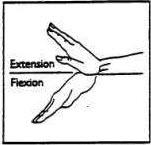
Flexion is the bowing of the wrist or moving the palm toward the front of the forearm. Extension is the cupping of the wrist or bending the back of the wrist toward the back of the forearm.


Flexion or “bowing” of the left wrist decreases the loft of the clubface while extension of the left wrist adds loft.
Here’s Graeme McDowell showing left wrist flexion through impact.
Left wrist extension or cupping is what is found in a typical golfer with a flip/roll slice and periodic hook.
Internal or External rotation of the left shoulder
Internal or external rotation pertains to the rotation of the humerus (upper arm bone) at the shoulder (not shoulder turn as we golfers like to think). A good example of internal rotation would be if you were pouring water out from a pitcher. The humerus would be rotating toward the center of your body.
External rotation would be if you were doing a “hitchhiking” sign. In this case, your humerus would be rotating away from your center. So here’s how it works in golf. See below.

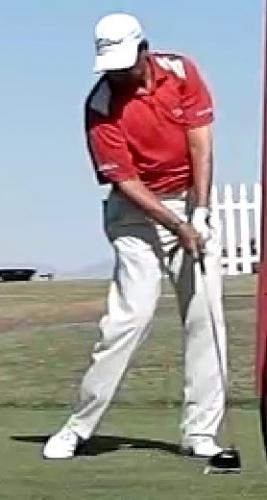
Kyle Stanley (left) displays internal rotation of the left shoulder which stabilizes impact, where the left elbow is pointed at the target. Tom Pernice Jr. shows external rotation of the shoulder. See his left elbow pointed more toward the white fence behind him.
Compare Scott Stallings’ internal rotation vs. Tom Pernice Jr. external rotation at impact. Tom’s creates more clubface rotation as you would imagine.
Frontal Plane Left Shoulder Abduction or Adduction

When viewed from front, abduction is pulling away from the body.
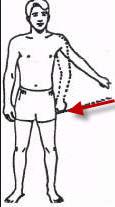
Adduction is pulling the arm toward the center of the body.
Drive/holders are pulling the left arm away from the chest and abducting.
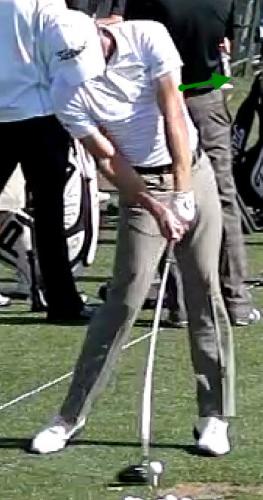
Here’s Kyle Stanley with this movement. One can see more space between his arm and chest.
Tiger 2008 still had this move.
Dean Wilson keeps the left arm connected to the chest.
Here’s another variation. Alex Cejka has left shoulder adduction and external rotation. This causes a stall in the arms and a greater chance for a flip/roll to occur. The adduction invites the club to pass the hands while the ER promotes increased rotation of the arms/clubface.
Here’s Rory with his version of left shoulder adduction while holding internal rotation. At the start of the animation his left arm has separated from his chest. Yet, it begins to adduct or pull back towards the chest.
Left Elbow Flexion or Extension
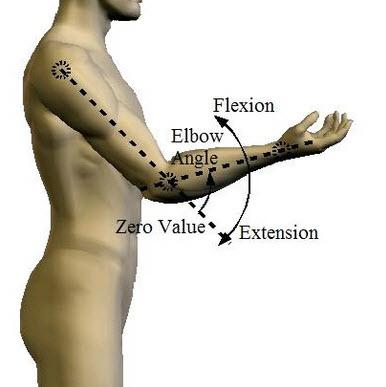
This movement is familiar to most people. Flexion is bending the elbow while extension is straightening the elbow.
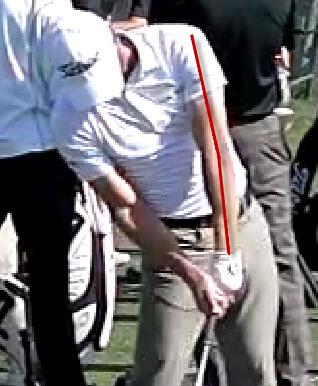
The left arm is slightly bent (elbow flexion).

Generally speaking, left elbow extension comes with an extended left wrist (cupping) and is therefore not recommended if you’re trying to drive/hold.
Sagittal plane view Left Shoulder Extension or Flexion
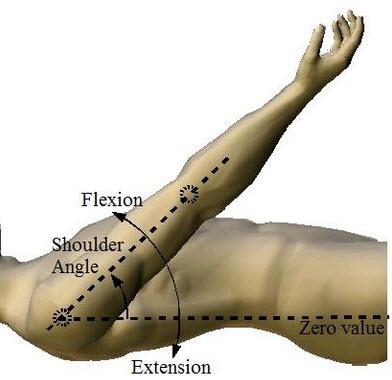
Though these pictures are showing right shoulder movement, left side movements are the same. Side view is a bit difficult to see and discern since the amount of rib cage rotation can influence this position. So we have to think in terms of where the arm would be if at one’s side is neutral.
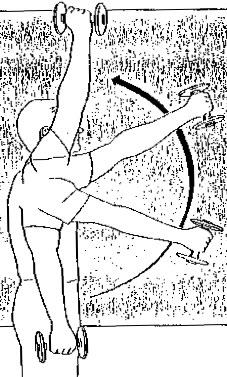
Lifting the arm up in front of you is shoulder flexion.
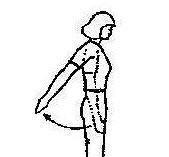
Pulling the arm behind is shoulder extension.
This side view shows slight left shoulder flexion with the arm rising.
JB Holmes would be doing the opposite or moving toward a more neutral position. Some people might characterize left shoulder extension as “swinging left.”
While this is a different view, one can clearly see that Lee Westwood’s left shoulder extends (left arm pulls away from ball) even more than JB’s.
This would be an extreme case of left shoulder flexion. Compare left arm extension to left arm flexion through impact.
Rate of Right Wrist Flexion (could also be called rate of flip or ROF)
Other attributes of a drive/holder would be a slightly bent left elbow that can either extend post-impact or stay slightly bent while continuously pulling up and behind. The right wrist of a drive/holder moves from extension to slightly less extended at impact. In other words it is moving toward flexion but it doesn’t actually get to the flexed position. Drive/holders have a slow ROF.
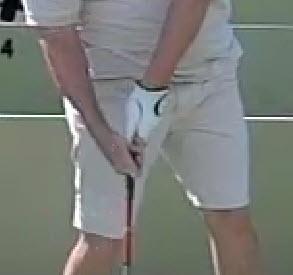
On the other hand, amateur flippers will be in right wrist flexion at impact since their ROF is so high.
Retention of the left forearm speed
This movement may not be so obvious but is extremely important in lowering your rate of flip.
The club is beginning to release and ready to pass the left forearm. The amateur’s common error would be to allow the flip to continue or, worse, add more force to the flip. For those who already have the left forearm in pronation and left wrist in extension (cupping) just prior to impact, you may need to think of supination/flexion at impact to feel like you’re re-accelerating the left arm and avoid a flip release. Here’s Ian Poulter doing this.
This is a low handicap player with a medium to high ROF. Not so uncommon even amongst low handicap amateurs.
This is a middle handicap player with a higher ROF.
While some “experts” may believe in maximizing clubhead speed through the kinetic chain snapping of the clubhead past your hands, perhaps they might want to consider what happens if this increases your ROF and therefore increases loft and spin? By trying to get you the additional mile or two per hour increase by snapping that kinetic chain, they considerably decrease your distance due to added spin and loft. Now your 7 iron plays like a 9 iron. One step forward, two steps back...
Right Forearm Supination or Pronation
Matt Kuchar slightly supinating.
Drive/holding scratch player has right forearm pronating until just before impact.
Then right forearm pronation stops and has small movement in the opposite direction (supination).
Phil as a righty is pronating.
This is a flip/rolling slicer with his right forearm supination along with right wrist flexion from well before impact.
Right Elbow Flexion or Extension
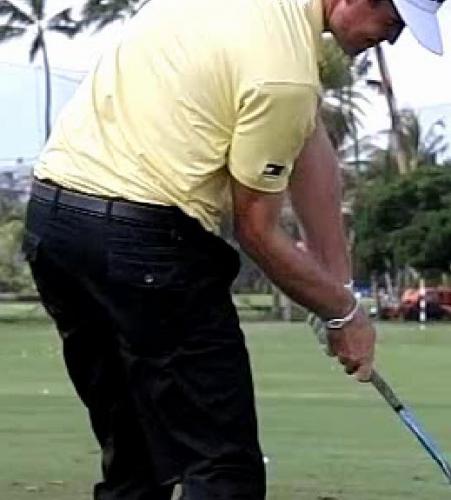
Right elbow flexion is another way of saying that the arm is bent. The drive/holders will tend to have their arms bent more than others.

Brian Gay has his right arm only slightly bent prior to contact.
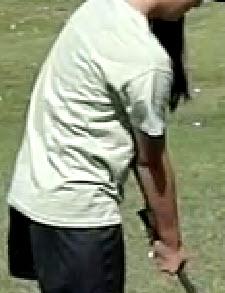
An amateur can have the right arm fully extended at impact.
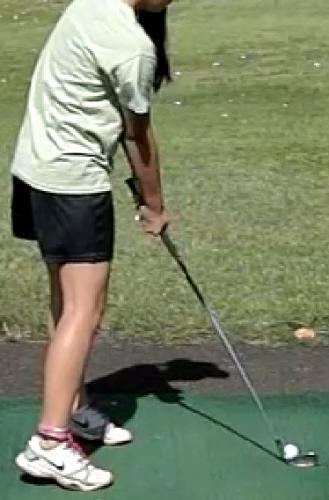
But it widens the arc early and could cause a dreaded sh...
Sagittal Plane Right Shoulder Extension or Flexion
Keegan keeps his right shoulder in a stable position slightly in flexion until impact. Right after impact, right shoulder flexion increases.
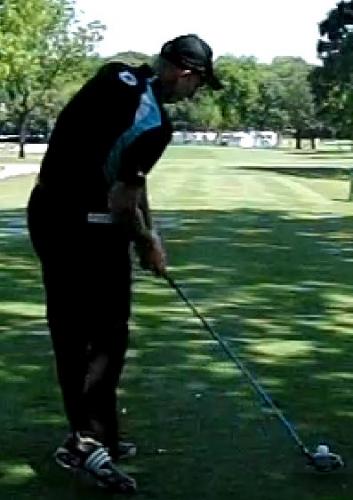
Jim Furyk is very stable as well but has his elbow/arm behind his hip at impact (extension).
Contrast these movements to Natalie Gulbis who is increasing the amount of right shoulder flexion in the frames prior to impact. This can cause the path to shift more to the right causing a higher rate of closure and thus more inconsistency.
Frontal Plane Right Shoulder Adduction or Abduction
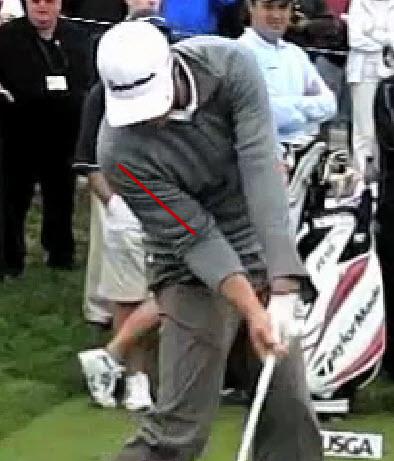
This movement is tied to timing of right shoulder internal rotation. The longer one can hold external rotation of the right shoulder and the better the body rotation, the more adducted the right shoulder will be.
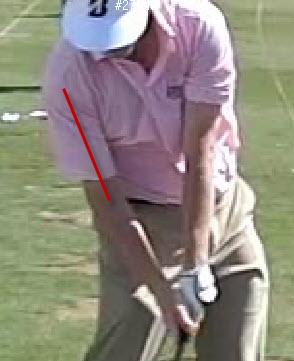
Brandt Snedeker has less right shoulder adduction.
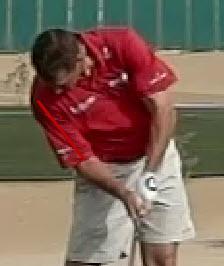
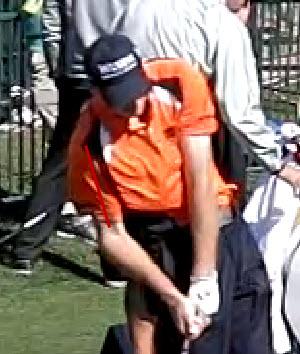
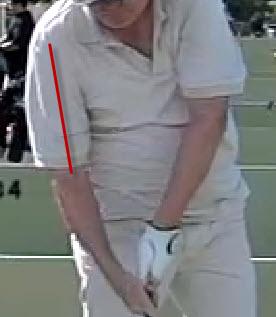
Slicers can have the right shoulder abducted way early due to right shoulder internal rotation occurring prematurely. See next component.
Timing of Right Shoulder Internal Rotation (Late vs. Early)
This movement may occur at the start of the downswings for an over-the-top swinger. Drive/holders will hold external rotation till just before impact and then release to internal rotation. Yet, you can then have Westwood’s early internal rotation which occurs in the middle of his downswing. So there’s a wide range in the timing of this movement.
Ulnar (UD) or Radial Deviation (RD) of wrists
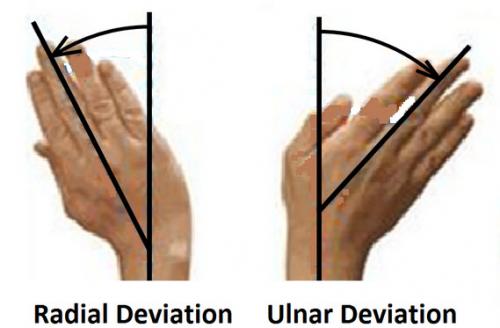
Radial or ulnar deviation occurs in the wrists. Radial deviation is the bending of the wrist toward the thumb or radial bone while ulnar deviation is the bending of the wrist toward the pinky or the ulna bone. But due to differences in shoulder movements and arm positions, UD or RD in the left or right wrist can occur concurrently or independently of each other.
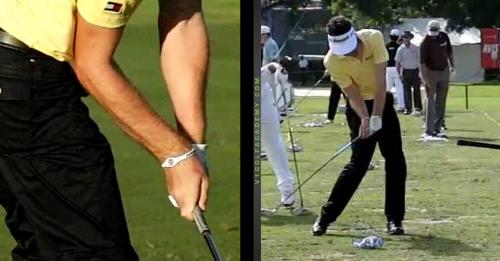

Here’s Keegan with his wrists moving toward ulnar deviation at impact and reaching maximum amount just after impact. In addition to stabilizing impact, this also moves the club path left…..a key to hitting the ball straight.
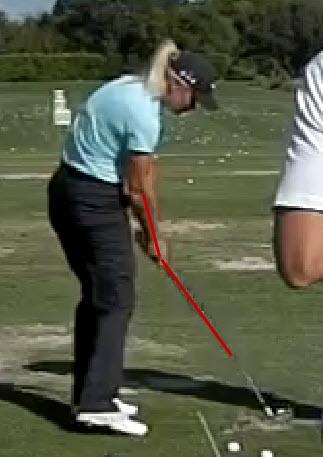
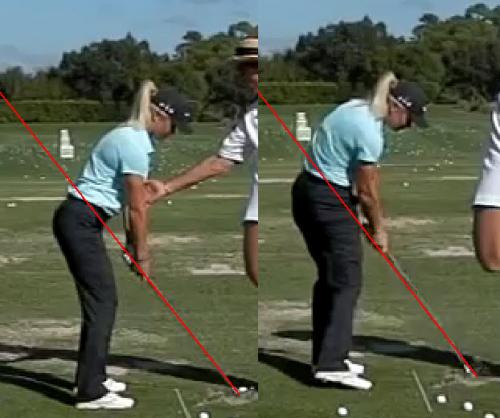
Returning to the shaft plane at impact! But if it results in moving both wrists to radial deviation, it is greatly reducing the stability of impact.
Body Movements Affecting Release
Lateral Bend
Comparing Graeme McDowell with Francesco Molinari highlights the difference between a drive/holder retaining lateral bend vs. others. Without the lateral bend one cannot rotate through impact in a unified way. Typically this causes a stall and this will cause the right shoulder to fire towards internal rotation earlier, which means early release. Fortunately for Molinari, this occurs close to impact. Unfortunately for amateurs, the release starts way earlier and causes a plethora of problems.
Retaining Lordosis
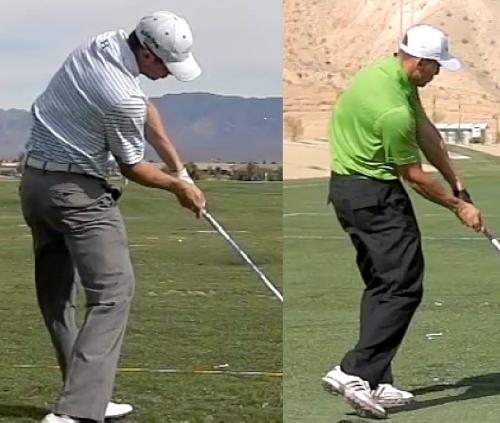
Driver/Holders retain lordosis as well. Typically, when losing one’s “spine angle”, both the lordosis and lateral bend are gone. This causes the upper body to straighten and the shoulders to lose their tilt.
In the next article, we look at the various movements that we have examined to see how they work together for the various release types to affect ballstriking accuracy and consistency.
But before we part, here’s a new episode of…
Back to the Future
Perhaps the most interesting development in the world of golf during this early part of the season is Tiger Woods’ drastic improvement. He’s driving it straighter and his misses are not so bad. But does this represent a movement towards a “Foley” swing or release pattern? Let’s apply our anatomical release movement structure to analyze what the “new and improved” Tiger is doing. Since we only have high speed video from 2008, that will have to be our starting point. So, from left to right, here’s Tiger 2008 (last major victory in Haney era), Tiger 2011 (working hard with Foley) and Tiger 2013 at Doral.
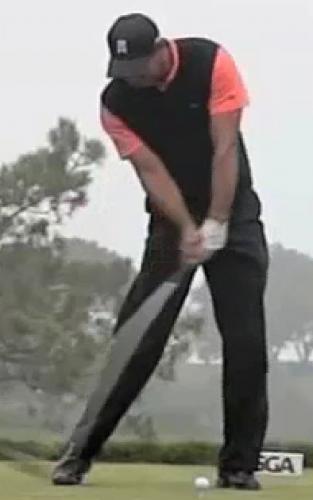
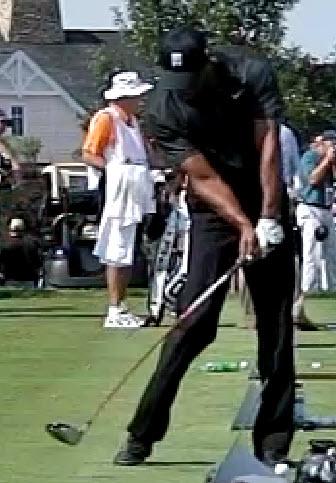
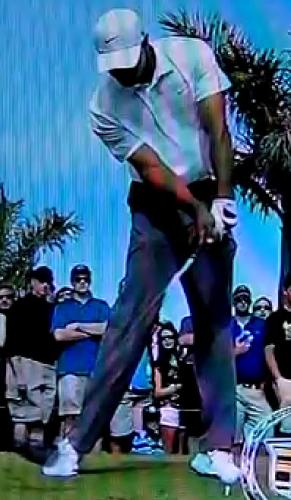
If we’re just looking at the key movements, left forearm supination and left wrist flexion, which one of these three Tigers looks different from the others? If you picked the middle one, you’re right. Tiger 2011 shows a pronated left forearm and a slightly extended left wrist.

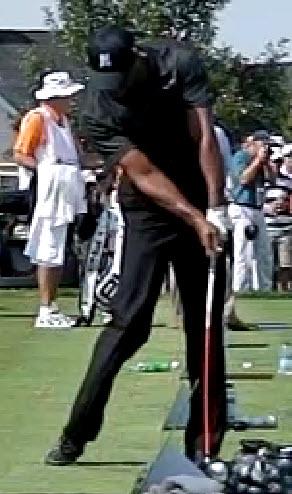
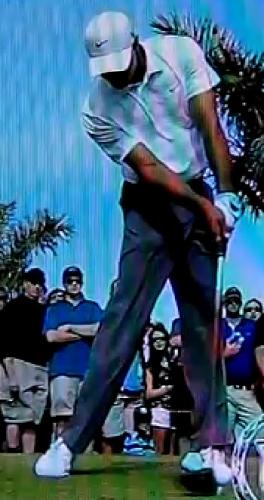
Now look at the left shoulder. Which two have more internal rotation? Looks like for both Tiger 2008 and Tiger 2013 the left shoulder is internally rotated while in 2011 he’s externally rotating his shoulder (see left elbow rotated toward his ribs). The left shoulder external rotation is also usually paired with left shoulder adduction (pulling into chest) instead of abduction (pulling away). Although Tiger manages to avoid this pairing, there certainly is less abduction. I’ll call that staying neutral.
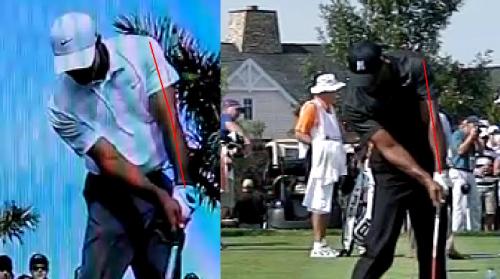
See the left elbow in slight flexion vs. extension?
Another key difference resides in the right forearm movement. In contrast to Tiger 2008 and Tiger 2013, Tiger 2011 has right forearm pronation. This movement along with his left forearm supinating fast and very late in the impact zone creates an explosive combination of rotational components of the clubface. That’s generally not what you want but, in the 2011 swing, it might be a much needed last millisecond “saving” of the shot since the left forearm pronation before impact had left the clubface more open.
The following table compares Tiger's release movements at three different points in the last five years. He worked so hard to learn the new swing in 2010 and 2011 yet played his worst ever. Now Foley has him working to clear his hips faster and swing left. Why work so hard to go back to what he used to do???
| Anatomical Movement | Tiger 2008 | Tiger 2011 | Tiger 2013 |
| left forearm | early supination | pronation then late and fast supination | early supination |
| left wrist | flexion | extension then moving to flexion post impact | flexion |
| left shoulder | internal rotation | external rotation | internal rotation |
| left shoulder frontal plane | abduction | neutral less abduction | abduction |
| left shoulder sagittal plane | slight flexion | more flexion | slight flexion |
| left elbow | flexion | extension | flexion |
| right forearm | supination | pronation | supination |
| right wrist | flexion low rate | flexion low rate | flexion low rate |
| right shoulder | late internal rotation | late internal rotation | Late internal rotation |
| right shoulder frontal plane | adduction | adduction | adduction |
| right shoulder sagittal plane | increasing flexion | increasing flexion | increasing flexion |
| right elbow | slight flexion | extension | slight flexion |
| both wrists | moving to UD max after impact | moving to UD max after impact | moving to UD max after impact |
| lateral bend | lateral bend | lateral bend | lateral bend |
| Lordosis | lordosis | lordosis | lordosis |
Lastly, Andre Van Staden of New Zealand has been working with me for a few years and has reached level 2 of my certification program. He works with high level players from his country and will someday have a player on the PGA tour. He understands the spine engine and anatomical movements very well and can help golfers of all levels improve. Here is a sample of his work with comments from Andre.
When I started working with Catherine, she was a 12 handicap. We have worked really hard on her leg movements on the downswing. She internally rotated her right leg immediately from the top of the downswing, which meant that she only had her hands and arms left to use for power through the impact zone. This also resulted in a flip rolling release pattern, which resulted mainly in a loss of power (she was still remarkably accurate despite the rolling!). Here are a few points of what we worked on:
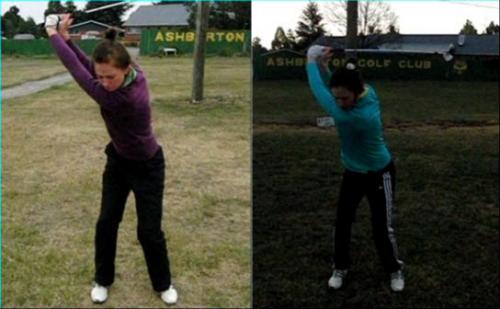
Old swing on the left is more centered at top of backswing. Now, she’s more right side loaded.
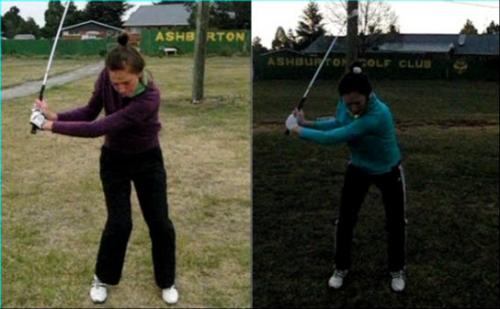
On the left she’s firing her right leg internally at the start of the downswing vs on the right she’s in dual external rotation. Also she has improved her elbow move and lateral bend. Notice the high right shoulder in “before” picture which indicates lack of lateral bend.
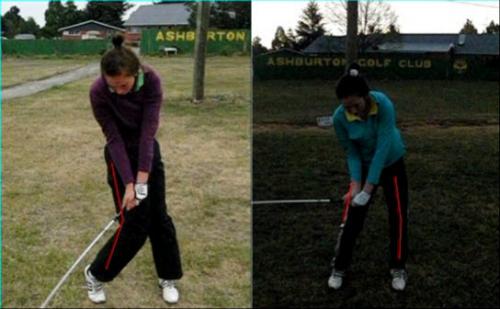
By this point on the downswing she’s all but done firing with the body. All that’s left is to flip/roll. Whereas now that she didn’t fire her right side so early, she can continue to rotate through impact. Also note the early supination of her left forearm instead of pronating and releasing angle early.

Now she’s got more body rotation through impact and a drive/hold release with a very stable clubface going through impact. She is now a scratch handicap and has represented New Zealand at under 19 level on 2 different occasions. We are constantly working on maintaining the changes so that they become completely ingrained and natural.

